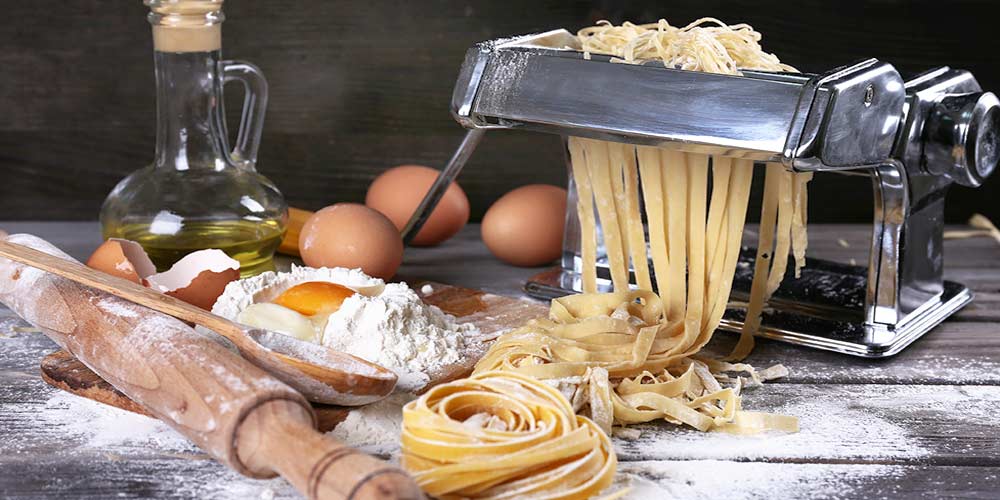Pasta is a beloved dish around the world, and nothing compares to the taste of fresh, homemade pasta. Whether you’re making lasagna, ravioli, or your favorite noodles, a pasta machine can elevate your cooking experience. However, finding the best pasta machine can be daunting. With countless options available online, choosing a high-quality, reliable, and easy-to-use machine can be overwhelming.
This guide will help you navigate the world of pasta makers, focusing on the top models that deliver consistent and high-quality results. We’ll explore the features that make a pasta machine stand out, compare the best options, and provide tips for making the perfect pasta at home.
Why Invest in a Pasta Machine?
Experience the Authentic Taste of Fresh Pasta
One of the primary reasons to invest in a pasta machine is to enjoy fresh, homemade pasta that surpasses store-bought alternatives. Fresh pasta has a unique texture and flavor, allowing you to customize your recipes and impress your family and friends with gourmet dishes.
Consistent Quality and Uniformity
A high-quality pasta machine ensures consistent results, producing even sheets of dough perfect for lasagna, ravioli, and various noodles. Consistency is key in cooking, and a reliable pasta maker ensures your dishes look and taste professional.
Creativity and Customization
Owning a pasta machine opens up endless culinary possibilities. You can experiment with different flours, flavors, and shapes, tailoring your pasta to your preferences and dietary needs. From spinach-infused fettuccine to gluten-free tagliatelle, a pasta machine allows for creativity in the kitchen.
What to Look for in the Best Pasta Machine
When searching for the best pasta machine, there are several key features to consider:
Material and Build Quality
The best pasta machines are built to last, using durable materials like stainless steel. Stainless steel machines are robust and resistant to corrosion, ensuring they withstand the test of time.
Manual vs. Electric
Pasta machines come in two main types: manual and electric. Manual machines require more hands-on effort but offer greater control over thickness and texture. Electric machines are more convenient and time-saving, ideal for those who frequently make large batches of pasta.
Ease of Use and Cleaning
A good pasta machine should be easy to assemble, use, and clean. Look for machines with straightforward instructions and removable parts that simplify the cleaning process.
Versatility and Attachments
Some pasta machines come with interchangeable attachments for making different types of pasta, such as spaghetti, fettuccine, and ravioli. A versatile machine with multiple attachments offers more value and versatility in the kitchen.
Price and Warranty
Price is an important consideration when purchasing a pasta machine. While investing in a high-quality machine is worthwhile, you can find excellent options at various price points. Additionally, check for a warranty to ensure your investment is protected.
Top 5 Best Pasta Machines
Here’s a closer look at the top pasta machines available on the market:
1. Marcato Atlas 150
The Marcato Atlas 150 is a classic choice for home cooks and professional chefs. This Italian-made pasta machine is known for its durability, ease of use, and consistent results.
Features
- Material: Made of chrome-plated steel with anodized aluminum rollers
- Adjustable Thickness Settings: Nine settings for precise control
- Versatility: Includes a pasta cutter for fettuccine and tagliolini
- Optional Attachments: Additional accessories for different pasta shapes
- Ease of Use: Simple operation with a hand crank
Pros
- High-quality construction ensures longevity
- Offers excellent control over pasta thickness
- Compatible with a range of accessories
Cons
- Manual operation requires more effort
- Initial setup may take some time
2. Philips Pasta and Noodle Maker
The Philips Pasta and Noodle Maker is an electric pasta machine designed for convenience and efficiency. It automates the process, making it perfect for busy home cooks.
Features
- Material: Durable plastic and stainless steel
- Automatic Mixing, Kneading, and Extruding: Hands-free operation
- Customizable Settings: Different programs for various pasta types
- Included Discs: Four shaping discs for spaghetti, penne, fettuccine, and lasagna
- Built-in Storage: Convenient storage for accessories
Pros
- Time-saving with automatic functions
- Easy to use, even for beginners
- Quick pasta-making process
Cons
- Higher price point
- Limited control over thickness
3. Imperia Pasta Machine
The Imperia Pasta Machine is a traditional manual pasta maker that delivers authentic Italian pasta. It’s renowned for its sturdy build and smooth operation.
Features
- Material: Heavy-duty stainless steel
- Adjustable Settings: Six thickness levels
- Pasta Cutter Attachment: Includes attachments for spaghetti and fettuccine
- Optional Accessories: Compatible with additional cutters
Pros
- Durable and long-lasting construction
- Provides excellent pasta texture
- Offers control over thickness and texture
Cons
- Manual operation requires physical effort
- Basic attachments included
4. KitchenAid Pasta Roller & Cutter Set
The KitchenAid Pasta Roller & Cutter Set is an attachment set designed for use with KitchenAid stand mixers. It offers convenience and versatility for those who own a mixer.
Features
- Material: Stainless steel construction
- Three-Piece Set: Includes a pasta roller, spaghetti cutter, and fettuccine cutter
- Adjustable Settings: Nine thickness settings
- Easy Attachment: Compatible with KitchenAid mixers
Pros
- Utilizes existing KitchenAid mixer
- High-quality construction
- Easy to use and clean
Cons
- Requires a KitchenAid mixer
- Limited to mixer owners
5. Cuisinart Pasta Maker Attachment
The Cuisinart Pasta Maker Attachment is another option for those with stand mixers. It offers a range of pasta-making options and high-quality construction.
Features
- Material: Durable stainless steel
- Six Pasta Plates: Includes discs for spaghetti, macaroni, rigatoni, fettuccine, lasagna, and bucatini
- Easy to Attach: Fits Cuisinart stand mixers
- Adjustable Settings: Customizable thickness and shape
Pros
- Versatile with multiple pasta options
- Easy to attach and use
- Sturdy and reliable
Cons
- Requires a Cuisinart stand mixer
- Additional cost if mixer not owned
Tips for Making Perfect Pasta at Home
Creating delicious homemade pasta requires some practice and attention to detail. Here are some tips to help you make the best pasta possible:
Choose Quality Ingredients
The quality of your ingredients significantly impacts the final product. Use high-quality flour, fresh eggs, and clean water for the best results. Consider using semolina flour for added texture and flavor.
Knead the Dough Properly
Proper kneading is essential for achieving the right dough consistency. Knead the dough until it’s smooth and elastic, ensuring it’s neither too sticky nor too dry.
Let the Dough Rest
Allow the dough to rest for at least 30 minutes before rolling it out. Resting helps relax the gluten, making the dough easier to work with and improving its texture.
Use the Right Thickness SetZting
When rolling out the dough, start with the thickest setting on your pasta machine and gradually decrease the thickness. This process helps achieve even sheets and prevents tearing.
Dust with Flour
Lightly dust the dough with flour to prevent sticking while rolling and cutting. Use just enough flour to keep the dough manageable without making it dry.
Cook Fresh Pasta Correctly
Fresh pasta cooks more quickly than dried pasta. Boil it in plenty of salted water for 2-4 minutes, testing for the desired texture. Avoid overcooking, as fresh pasta becomes mushy quickly.
Experiment with Flavors
Get creative with your pasta by incorporating different flavors. Add herbs, spices, or vegetable purees to the dough for unique and delicious variations.
Caring for Your Pasta Machine
Proper maintenance of your pasta machine ensures its longevity and optimal performance. Here are some tips for caring for your pasta machine:
Clean Thoroughly After Use
After each use, clean your pasta machine thoroughly. Remove any dough remnants and clean the rollers with a soft brush or cloth. Avoid using water, as it can cause rust and damage.
Lubricate Moving Parts
Regularly lubricate the moving parts of your pasta machine to keep it operating smoothly. Use food-grade mineral oil for lubrication, following the manufacturer’s recommendations.
Store in a Dry Place
Store your pasta machine in a dry place to prevent moisture-related damage. Cover it with a dust cover or store it in its original packaging for protection.
Follow Manufacturer’s Instructions
Always follow the manufacturer’s instructions for care and maintenance. Adhering to these guidelines ensures your machine remains in good condition and functions properly.
Conclusion
Finding the best pasta machine is an exciting journey that can enhance your culinary skills and bring the joy of fresh pasta to your kitchen. Whether you choose a manual machine for hands-on experience or an electric one for convenience, the key is to select a machine that suits your preferences and lifestyle.







